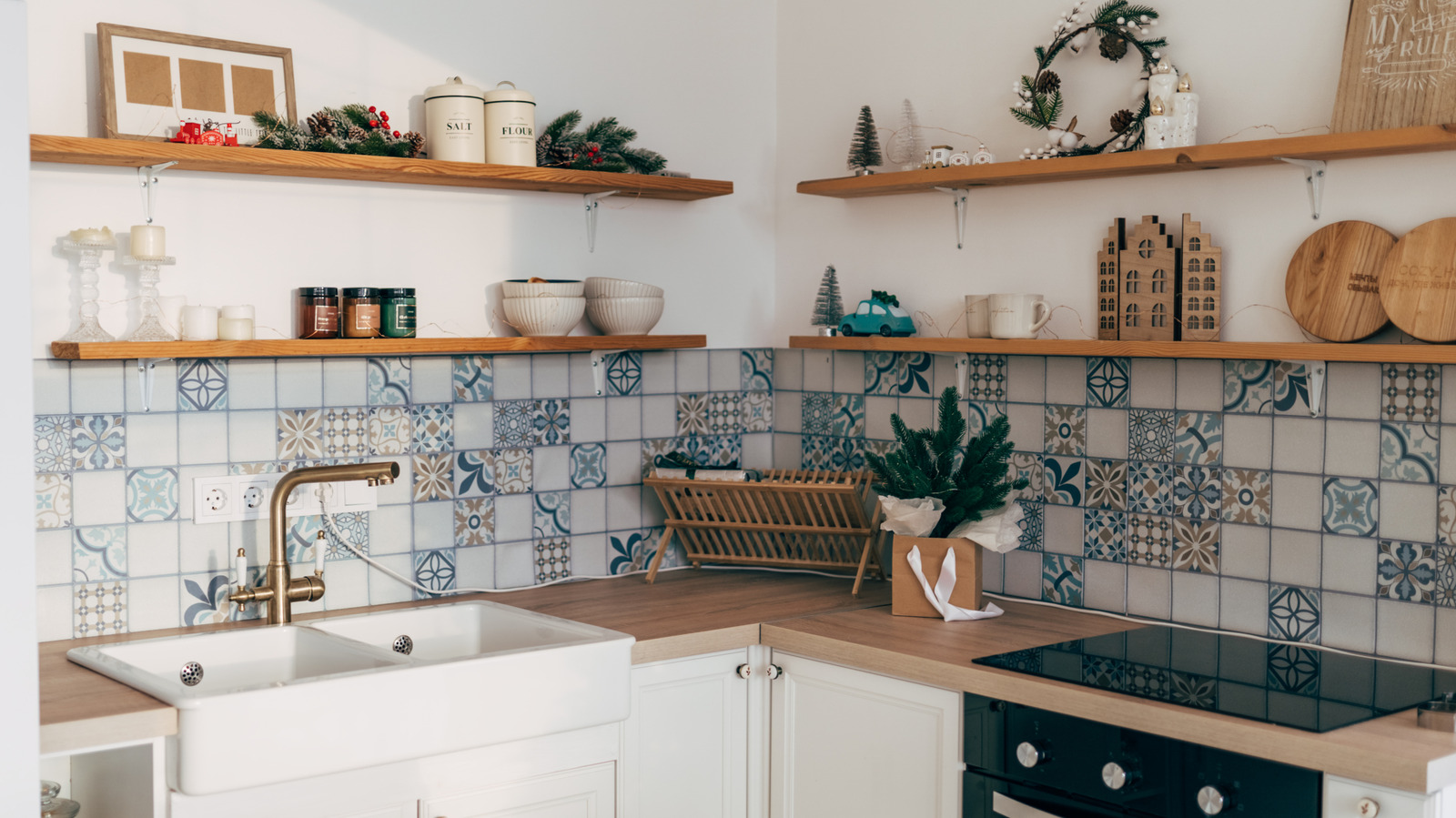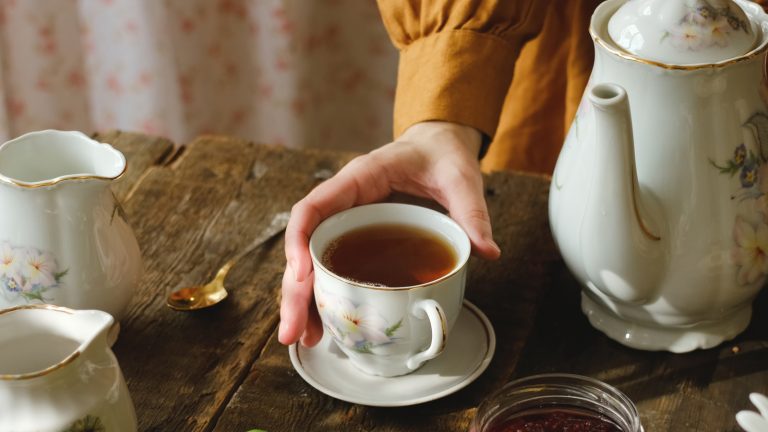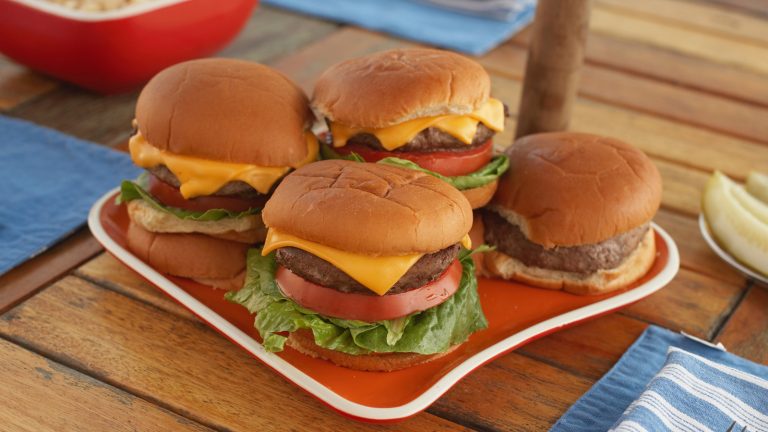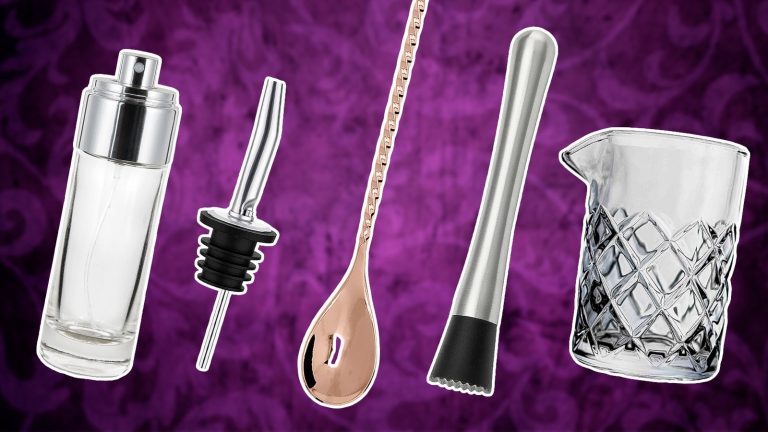Along with an addictive podcast, a perfectly set mise en place, and good company, a well-organized kitchen promotes the joys of cooking by simply amplifying your surroundings. With the rise of home renovations in recent years, projects such as investing in a kitchen island or giving your kitchen’s cabinets a little facelift could be the answer to your cooking woes — and a cure for an ordinary-looking kitchen space.
More and more homeowners seem to be ditching the drab, closed-off veneer of traditional cabinets. Instead of forking over the money to install modern models, try simply removing the unwanted cabinet doors and embracing the spacious look of open shelves. Not only do doorless pantries expand the possibilities of a home’s cooking space, but their accessibility also encourages dwellers to unclutter their kitchen and embrace more intentional organizational practices.
But how do you organize and adorn an open-cabinet kitchen? We’ve dreamed up 11 ideas to spruce up your shutterless cabinets (and perhaps even inspire some of you to get your screwdriver handy and say “buh-bye” to the kitchen shelving of yesteryears). To help guide us through our interior design queries, we spoke to Joyln Chen, a Portland-based interior designer and co-owner of Xiao Ye, which she also designed. With little more than a bucket of paint and a free afternoon, these simple ways to spruce up your kitchen will have you ready to log even more hours in an apron.
Paint your shelves
Bracing yourself for a messy afternoon of painting might be the most obvious way to zhoosh up open kitchen shelving. Select both a color and a style to adorn your stylish cabinet choice. Firstly, consider the surrounding wall colors, the tones of your dinnerware, adjoining windows, and the hue of big appliances like your oven and refrigerator before committing to a cabinet shade. Hone in on complementary colors to stain the frames and/or shelves and avoid shades that could darken or dull your space.
Chen warns that heavy use can endanger the integrity of paint. “At the restaurant, we painted the front and sides of our scalloped bar shelving to match the beadboard wall color to its more monochromatic,” she said. “But I had the tops of the shelves made with inset laminate to increase durability in a restaurant setting and avoid scratches when we slide liquor bottles on and off the shelves.”
If your existing kitchen already embraces a playful color scheme — like painted kitchen appliances – consider laquering your shelves in two or more colors for a Memphis Design Group style, which current kitchen brands like Bodum, Great Jones, and West Elm all recently riffed on with multi-colored tools and utensils. Or, for a more toned-down and evergreen approach to re-coloring your shelves, simply paint the trim (the exterior frame or exposed areas) while leaving the internal space untouched, or white. This technique cuts back on paint and effort while not overcommitting to a single color. In either case, remember to select hues you’re confident you won’t tire of quickly, since you’ll be greeted by them every day.
Line with contact paper
Combat the demons of grease rings and splinters elegantly by lining shelves with adhesive contact paper or sticky laminate. Yes, the extra step requires the painstaking task of meticulously measuring each sheet of contact paper exactly to each shelf’s dimensions before delicately matching the new layer to the rack. But the moments of hardship pay off daily in both aesthetic and practical applications.
A little glimmer of colored paper or cutesy patterns peeking out from the flat surfaces holding platters and wine glasses adds a style panache. More importantly, it protects the wood surfaces under the contact paper from condensation rings (left from half-heartedly drying dishes), and your fingers from accidentally finding any errant wood slivers poking up from the surface. A relatively low investment — especially considering the astronomical price of replacing an entire set of cupboard doors — sticky contact paper only costs a few dollars a roll. And if you’re extra proud of the unique laminate you chose, perhaps line the wall of your cabinet and even the interior of your drawers with the contact sheets to maximize the effect of the colored paper.
Uniform canisters
If uniform tidiness rules your domicile, ditching the original packaging of kitchen essentials such as flour, rice, sugar, coffee, and beans in lieu of matching, translucent canning jars or plastic canisters cleans up the overall look of open shelving. Though at first the project of transitioning to your own vessels seems like an arduous (if not messy) task to take on, once the changeover takes place, you’ll only need to incrementally refill each container.
To possess complete control over the design of your kitchen, kiss clashing branding goodbye as you pour Goldfish Crackers or Rice Krispies Cereal into your house-approved containers. Plus, clear vessels also helpl guests find their desired items without much poking around.
“At home, I decant most things and use restaurant deli containers as food storage containers because they’re durable and dishwasher safe and hand labeling and dating the containers like we do at the restaurant not only creates visual uniformity to a stack of containers, but also we know how long we’ve had that item on our shelves,” Chen advises.
Once you’ve fully immersed yourself in your container system, save the planet one purchase at a time by shopping from grocery store bulk bins for items like oats, nuts, and spices for your kitchen replenishments instead of depending on wasteful packaging. In some cities, the zero-waste movement even inspired entirely package-free groceries like at Portland, Oregon’s The Realm Refillery, which offers guests a sustainable alternative to conventional supermarkets. But whether shifting your kitchen to uniform containers is a decorative choice or you’re going green, finding the exactly right vessels will redefine your space in one fell swoop.
Color code
If you’re one of those hyper-aesthetic folks who somehow find time to color-code their closets, bookshelves, and even iPhone apps, then take your organizational fixation to your shelves and arrange your cooking space based on hue. Own a handful of festive blue and green glasses fit for margarita night? Instead of housing them with crystal wine glasses and your morning mugs, lovingly display their pops of color alongside similarly-toned bowls, platters, and pitchers.
Visually-oriented people already remember desired devices based on appearance rather than function, so lifehack your way to instant organization by segmenting your open cupboards to coordinate colors. Anything large enough to live outside the hidden spaces of utensil drawers can rest amongst like-toned or patterned tools and vessels, inviting guests to discover your style by perusing your collection. Not for households with too many piecemealed dining sets, the effect works best in homes with somewhat uniform collections of nesting bowls, glasses, dishes, measuring cups, etc.
Extend this novel organizational flair to your snack shelves, grouping the boxes and bags of your favorite store-bought items based on their brand’s signature colors. Love Corn Pops cereal? Untether your box from its breakfast relatives and set it next to its yellow-branded brethren like Lays potato chips, Wheat Thins, Nilla Wafers, and Velveeta mac-and-cheese.
Knick knacks
Think of yourself as somewhat of a collector? If your shelves allow for it, think of scattering bits of sentimentality throughout your open cabinets. Unlike closed cupboards, removing the hinge system from your shelving units also opens opportunities to display your knick-knacks and prized tchotchkes you’ve collected over the years.
Bring back the kitchy cutesy salt and pepper shakers of yesteryear, enjoy easy access to a shot glass filled with toothpicks, or show off the perfectly removed wishbone you fished out of your roast chicken along the edge of your shelving.
Or, if you’re one of the lucky folks whose kitchen brims with shelving, dedicate entire units to meaningful trinkets and conversation starters. Polaroid photos or photobooth strips can also adorn the real estate of your shelves. Chen opts for both ornamental and functional as she keeps her most beloved kitchenware exposed for all to see: “It can be a great way to display your most cherished and beautiful plateware, colorful pots, and items that you use daily,” she said. Either way, don’t let the refrigerator door have all the fun anymore, and spread your unique personality and mushy mementos outside the kitchen’s walls.
Cookbooks
Displaying your book collection remains a universal and timeless strategy to brag about your intelligence, and the same rule extends to the shelves of your kitchen. But instead of boasting about having finished “Infinite Jest,” signal your advanced cooking skills to your guests by letting the spines of famous restaurant cookbooks like “Noma: Time And Place In Nordic Cuisine” and contemporary classics like “Dessert Person” silently convey the hours you clock inside the kitchen.
If you have the space to spare, curating an immaculate stack of food-centric volumes based on seasonality, recent obsessions, and timeless classics provides punches of color to a room that can teeter on sterility and homogeneity. Plus, reference books such as “The Wine Bible,” “Meehan’s Bartender Manual,” and “The Flavor Thesaurus” come in handy whenever you’re searching for pitch-perfect pairings, cocktail ratios, and innovative ways to substitute ingredients with what you have on hand.
Keeping authoritative voices close at hand feels like having a trusted guide watching over your shoulder as you attempt some of the kitchen’s most stressful feats. But with Bourdain, Child, and Nosrat at your fingertips, as well as souffles, laminated doughs, and Wellingtons, it feels a bit more achievable with food literature’s mentors lurking just overhead.
Plants
If you’ve been blessed with a green thumb, entertain the idea of housing both functional and decorative plants in your open shelving. Take advantage of the doorless cabinet setup by allowing plants to thrive amongst your pots and pans.
Though Chen considers herself “the worst plant mom,” she urges the plant curious to seek out an oxalis for shelves that get good indirect light. “Whenever it’s looking a little droopy, you can pour a little water from the sink to bring it back to life!” she said.
Or take your budding plant hobby to the next level and try growing simple edible plants and an herb garden like microgreens, mint, and chives, which you can trim to garnish your salads, toasts, and other kitchen creations. Not only will you save money on small grocery purchases, but you’ll also limit the guilt you endure tossing out spoiled herbs. Or, for another practical plant to line your open shelving, look to an aloe vera plant. The succulent requires infrequent watering and doubles as a living first aid kit. The next time you have an unwanted encounter with an oven rack, get overzealous while deep frying, or steam your skin instead of the intended vegetables, lop off a slice of the aloe plant for a natural burn relief and remedy.
Dividers
One drawback to entirely open cabinets is that any messy portion or mismatched section of the shelving shows for all to see. Provide a little structure to the sparse layout of open shelving by installing simple dividers to assist in your organizational process. Retailers accommodate the ultra-methodical kitchen dweller by now offering shelves, miniature drawers, and plate dividers for folks who need everything just so.
A strategy to maximize space, layering shelves atop your existing installed cabinets gives your shelves additional room when stacking short items like mugs and plates. Again, if your kitchen craves a bit of flair, the MoMA Design Store, as well as several other trendy online shops, provide eye-catching alternatives to the more basic white units found in conventional retail chains.
Most practical if your spice collection threatens to overtake an entire shelf on its own, the layered effect also provides a level of organization missing from most spice racks and offers an alternative to sifting, sorting, and fumbling your dried seasonings and spices as you piece together a meal. Also, purchasing dividers so individual plates can sit upright prevents your ceramics from rubbing against each other and eliminates the frustrating task of stacking and unstacking each dish to find the one you’re in search of.
Hooks
Again, if you’re looking to maximize the space you have at hand, think about installing hooks for items like mugs and wine glasses that can easily perch above flat dinnerware like plates and platters. Hooks for glassware are available in both semi-permanent screw-in variations and completely removable, slide-in versions that hug your shelving unit. Chen admits that oftentimes, open shelving systems are “underutilized or untouched, like a display of things that collect dust.”
But adding a supplementary rack allows you to suspend handled vessels like mugs away from settling dust, and protect stemmed wine glasses from sulling from the inside out. Dangling glassware also cuts the difference between deciding when to store glasses facing up or down, can spare you from the temptation to overcrowd your storage space, and forces you to thoughtfully cluster your cups and their compatriots.
Take Chen’s advice: “Try to not overcrowd the shelf and put out groupings of like items,” she said. “At the restaurant, we line up and uniformly stack water cups and wine glasses to make it all pleasing to the eye since it’s all open to our guests to see.”
Curtains
Not for every home, but if you can’t quite embrace the open shelf look completely, contemplate trying curtains for open shelving near the ground, or abbreviated tapestries for a cottage-core look. For those with small living spaces, resorting to a speed rack or ad hoc, opening shelving might be an easy answer to solving spatial woes, but placing excess open shelving near the floor can feel a little unsavory depending on your cleanliness habits. Thoughtfully placing a curtain or drape over the shelves lower than hip-level can alleviate any anxieties over lingering debris and dust.
Easily made from any desired fabric, you can either attempt to blend your extra shelving into the backdrop of your kitchen or draw attention to the cloth by selecting a commanding pattern or color. And for open shelving above your head, think of trimming the upper shelf with a half-length curtain to create textured trim. This doubles as a barrier to dust and rising kitchen oil and smoke settling on your top layer of dishware. The dem-veil also suggests a diner or vintage vibe à la “Mad Men” or “That ’70s Show,” so keep the curtain look in mind for open shelving at secondary homes like beach and lake houses to lean into a throwback charm we all need from a getaway.
Extra lighting
No kitchen is built perfectly, no matter how much intentionality went into predicting the potential vibe. And since the sun insists on moving around throughout the day, honing in on an ideal lighting system for your kitchen proves challenging — even for the design-leaning brains out there. To combat the sun’s finicky nature and rely less on overhead lighting, which can trigger headaches (and mediocre food photography), Chen looks to incrementally light your open shelving.
“I love the idea of putting little table lamps on open shelving. It’s a great way to soften the kitchen. If you can, plan an outlet just above one of the shelves so you can plug in a lamp,” Chen said. If your space denies you of an ideally placed outlet for your handpicked kitchen lamp, Chen advises: “Otherwise, so many companies are making portable table lamps that could be recharged elsewhere.” And for a little extra illumination while chopping veggies? “At the restaurant, I had LED strips installed under our scallop shelves to give more light to my team when they’re working. I always suggest adding a diffuser to those LED strips to make the light feel less harsh.”





